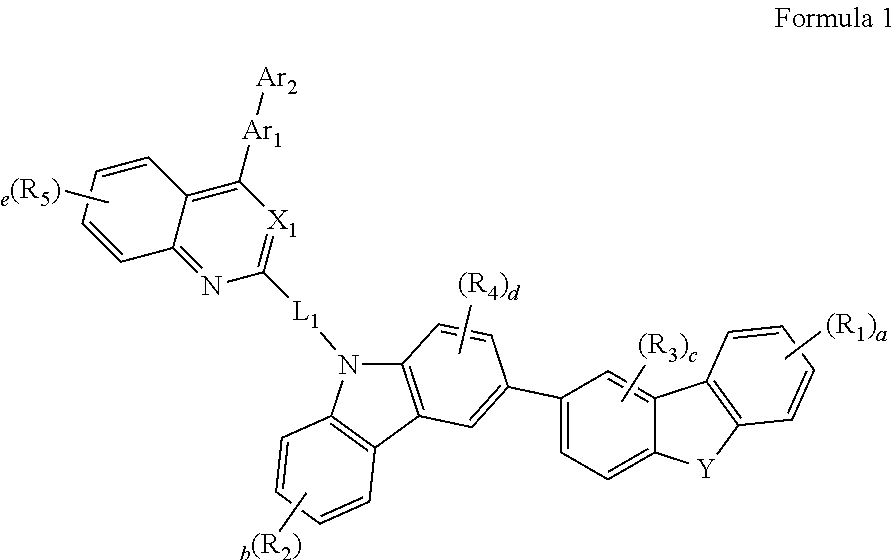Novel Organic Electroluminescent Compounds and Organic Electroluminescent Device Using The Same
a technology organic electroluminescent compounds, which is applied in the direction of indium organic compounds, thermoelectric devices, organic chemistry, etc., can solve the problems of short operation lifetime of organic electroluminescent devices, poor power efficiency (lm/w), and the need to improve luminous efficiency, etc., to achieve long operation lifetime, improve power efficiency and power consumption, and high luminous efficiency
- Summary
- Abstract
- Description
- Claims
- Application Information
AI Technical Summary
Benefits of technology
Problems solved by technology
Method used
Image
Examples
preparation example 1
Preparation of Compound C-3
[0053]
Preparation of Compound C-1-1
[0054]Dibenzo[b,d]furan-2-yl boronic acid (10.33 g, 48.76 mmol), 3-bromo-9H-carbazole (10 g, 40.63 mmol), K2CO3 (13.5 g, 97.52 mmol) and Pd(PPh3)4 (2.35 g, 2.03 mmol) were added to toluene 200 mL, EtOH 50 mL and purified water 50 mL. After stirring the reaction mixture for 3 hours at 90 to 100° C., the mixture was cooled to room temperature. An aqueous layer was removed from the mixture by a gravity separation. The obtained organic layer was concentrated, was triturated with MC, and then was filtered to obtain compound C-1-1 (9.75 g, 72%).
Preparation of Compound C-1-2
[0055]After dissolving 2,4-dichloroquinazoline (30 g, 151 mmol), phenylboronic acid (9.2 g, 75.3 mmol), Pd(PPh3)4 (2.6 g, 2.3 mmol) and Na2CO3 (16 g, 150 mmol) in toluene (300 mL) and distilled water (75 mL), the reaction mixture was stirred for 2 hours at 90° C. The mixture was distillated under reduced pressure to obtain an organic layer, and then was tritu...
preparation example 2
Preparation of Compound C-9
[0057]
Preparation of Compound C-2-1
[0058]9-phenyl-9H-carbazol-3-yl boronic acid (14 g, 48.76 mmol), 3-bromo-9H-carbazole (10 g, 40.63 mmol), K2CO3 (13.5 g, 97.52 mmol) and Pd(PPh3)4 (2.35 g, 2.03 mmol) were added to toluene 200 mL, EtOH 50 mL and purified water 50 mL. After stirring the reaction mixture for 3 hours at 90 to 100° C., the mixture was cooled to room temperature. An aqueous layer was removed from the mixture by a gravity separation. The obtained organic layer was concentrated, was triturated with MC, and then was filtered to obtain compound C-2-1 (12 g, 72%).
Preparation of Compound C-2-2
[0059]2,4-dichloroquinazoline (20 g, 0.1 mol), biphenyl-4-yl boronic acid (18.9 g, 0.1 mol), Pd(PPh3)4 (3.5 g, 3.01 mmol) and Na2CO3 (31.9 g, 0.3 mol) were added to toluene 800 mL, EtOH 200 mL and purified water 200 mL. After stirring the reaction mixture for 3 hours at 70 to 80° C., an aqueous layer was removed from the mixture by a gravity separation. The obt...
preparation example 3
Preparation of Compound C-12
[0061]
Preparation of Compound C-3-1
[0062]Dibenzo[b,d]thiophen-2-yl boronic acid (10.33 g, 48.76 mmol), 3-bromo-9H-carbazole (10 g, 40.63 mmol), K2CO3 (13.5 g, 97.52 mmol), and Pd(PPh3)4 (2.35 g, 2.03 mmol) were added to toluene 200 mL, EtOH 50 mL and purified water 50 mL. After stirring the reaction mixture for 3 hours at 90 to 100° C., the mixture was cooled to room temperature. An aqueous layer was removed from the mixture by a gravity separation. The obtained organic layer was concentrated, was triturated with MC, and then was filtered to obtain compound C-3-1 (9.75 g, 72%).
Preparation of Compound C-12
[0063]After suspending compound C-3-1 (5.5 g, 15.8 mmol) and compound C-2-2 (5 g, 15.8 mmol) in DMF 80 mL, 60% NaH (948 mg, 22 mmol) was added to the mixture at room temperature. The obtained reaction mixture was stirred for 12 hours. After adding purified water (1 L), the mixture was filtered under reduced pressure. The obtained solid was triturated with...
PUM
| Property | Measurement | Unit |
|---|---|---|
| phosphorescent | aaaaa | aaaaa |
| phosphorescence | aaaaa | aaaaa |
| luminous efficiency | aaaaa | aaaaa |
Abstract
Description
Claims
Application Information
 Login to View More
Login to View More - R&D
- Intellectual Property
- Life Sciences
- Materials
- Tech Scout
- Unparalleled Data Quality
- Higher Quality Content
- 60% Fewer Hallucinations
Browse by: Latest US Patents, China's latest patents, Technical Efficacy Thesaurus, Application Domain, Technology Topic, Popular Technical Reports.
© 2025 PatSnap. All rights reserved.Legal|Privacy policy|Modern Slavery Act Transparency Statement|Sitemap|About US| Contact US: help@patsnap.com



